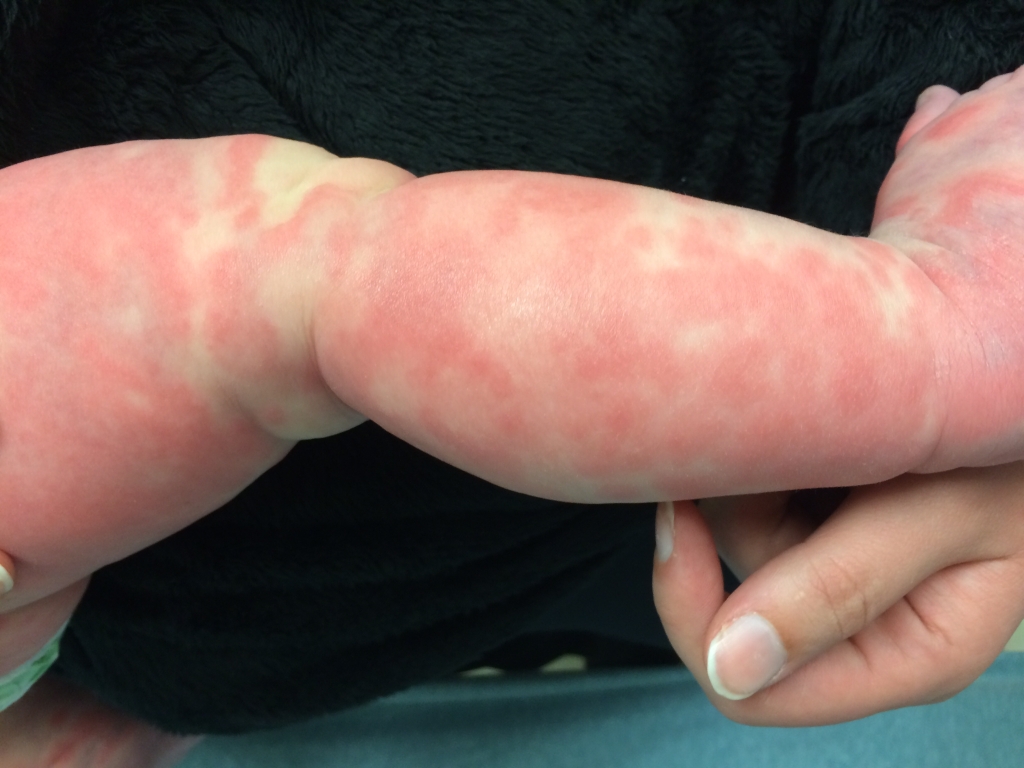You are seeing a child who is well appearing but has a dramatic rash. The rash appeared this morning and seemed to begin on her torso, later spreading to her limbs. The daycare thought that it was an allergy and was going to give her another child’s EpiPen, despite no respiratory symptoms and no history of previous allergy in the patient. Discretion won out, and the EpiPen was not given and the child was referred to the ED. You learn that she has had a fever to 38.9 C for 2 days, and her feet appear to be slightly swollen. This hasn’t limited her ability to walk, run or jump. Mom denies history of vomiting or diarrhea. there are no respiratory symptoms. She has no involvement of her eyes or mouth. Eight days ago she completed a course of cefdinir for otitis media.Let’s say that the rash in question looks like this:

The rash as it appears on the patient’s leg. 2014, Brad Sobolewski, MD, MEd
This rash is characteristic of erythema multiforme in the setting of a serum sickness like reaction. Serum sickness is a heterogeneous clinical entity where you will see variable rash, fever and polyarthlralgias. It begins 1 to 2 weeks following exposure to an offending agent. The offending agent varies, but the most common identifiable agents are antibiotics, including:
- Penicillins
- Trimethoprim-sulfamethoxazole
- Cephalosporins
Resolution generally occurs within 1-2 weeks after stopping the drug. In other cases it may be viral induced, but good luck discontinuing it. This process is immune complex mediated and results in the development a polymorphous, sometimes pruritic rash that starts in the trunk and spreads peripherally. They appear to be urticarial in some patients and like palpable purpura, maculopapular lesions or erythema multiforme-type exanthema in others. There is no involvement of the mucous membranes or eyes. Most patients develop remittent fever without temporal spikes. Two out of three have arthralgias, most commonly seen in the hands, wrists, feet, ankles and shoulders. The differential diagnosis includes:
- Viral exanthems (roseola)
- Hypersensitivity vasculitis
- Scarlet fever
- Acute rheumatic fever
- Meningococcemia
- Disseminated gonococcemia
- Reactive arthritis
- Lyme disease
- Still’s disease
- Kawasaki syndrome
- Stevens-Johnson syndrome
You can generally make the diagnosis clinically in most cases. Treatment consists of stopping the offending agent, NSAIDs for pain, and antihistamines for itching. Glucocorticoids may be useful in patients with severe arthritis/arthralgias or extensive rashes but in general do not have an evidence supported role. If you encounter an ill appearing patient, one with eye/mucous membrane involvement, or those in whom you are not certain about the diagnosis you might want to consider a complete blood count with differential, erythrocyte sedimentation rate (ESR) and C-reactive protein (CRP), urinalysis, blood urea nitrogen, creatinine, serum electrolytes, urinalysis and blood culture obtained to exclude other inflammatory or infectious causes. Again, if you are certain about the diagnosis you don’t need to get any labs. You should list the offending agent as an allergy – and if the patient encounters an offending drug again in the future the symptoms may have a more rapid onset. And finally, mucous membrane and eye involvement does not occur in serum-sickness like reactions. These findings should prompt consideration for Stevens-Johnson syndrome, a potentially fatal hypersensitivity reaction and (in my experience) the one reason for a Dermatologist to come in at night.
Fun fact: What was described today is actually serum sickness-like reaction. Classically serum sickness was in response to administration of a non-human species (horse) protein antigen. You may still encounter this today in sheep-derived Fab snake antivenom, heterologous immunomodulators containing murine components (rituximab and infliximab), streptokinase and the human diploid cell rabies vaccine.








